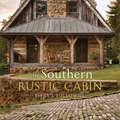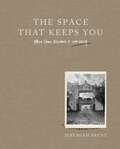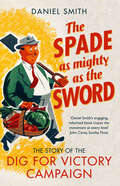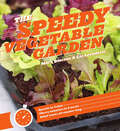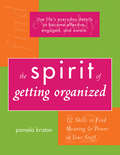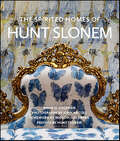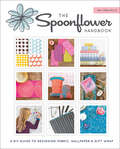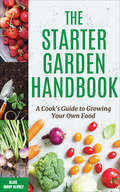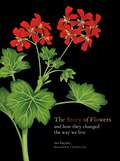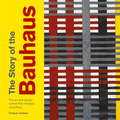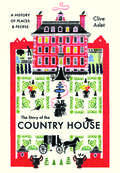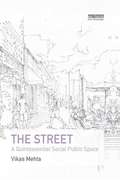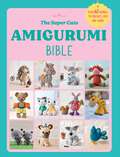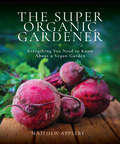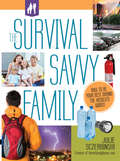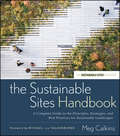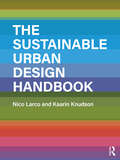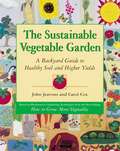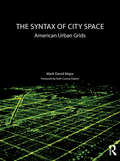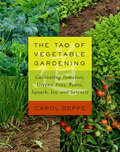- Table View
- List View
The Southern Rustic Cabin
by Emily J. FollowillExplore the beauty, tradition, and stylish renovation of rustic mountain homes across the Southern Appalachians in this gorgeously photographed book. The cool, wooded mountains of the South are dotted with log cabins, each with its own rich history and aesthetic charm. In The Southern Rustic Cabin, photographer Emily Followill captures the rugged beauty and unique personality of thirteen mountain homes located across Tennessee, Georgia, North Carolina, Alabama, and Virginia. The homeowners have lovingly preserved the age-old qualities of their cabins while renovating, revitalizing, and redecorating them to support modern living and reflect their personal style. Alongside her stunning photography of interiors and exteriors, Followill tells the story of how each cabin and owner came together; as the owners changed their cabins, the cabins invariably changed the owners as well.
The Space That Keeps You: When Home Becomes a Love Story
by Jeremiah BrentInterior designer and television host Jeremiah Brent explores the emotional meaning of home in this warm and inviting book that illuminates what make peoples’ spaces so personally significant.For many of us, our houses are more than just where we hold our belongings. They are reflections of who we are and where we’ve been. They represent our aesthetics, our personalities – provide us with purpose and intention, and if we’re lucky, a safe space to live and create. For years, Jeremiah Brent and his family lived in one beautiful home after the next. Yet after a short time, they always felt the pull to move on. Curious to understand why, he embarked on a deeply personal mission to discover what makes a home a space that keeps you.The Space That Keeps You isn’t just a study of beautiful interior design; it’s an emotional design book that explores what gives spaces meaning. Through candid conversations with nine individuals and families varying in backgrounds, lifestyles, and geographic locations, Jeremiah reveals how and why the spaces we inhabit come to feel like they truly belong to us—the memories, emotions, and stories that shape what home signifies.He introduces memorable people like the artist couple James and Alexandra Brown and their children who made an abandoned plot in Merida, Mexico their accidental paradise, and Tracy and Brian Robbins who found refuge during the pandemic in a serene single-story home in Montecito surrounded by fields of lavender. He illuminates a personal side of Oprah Winfrey as she speaks to the importance of nature in her dream of home, and describes the story of Giberto and Bianca Arrivabene, who fought to hold onto their family’s historic Venetian palazzo. Their stories are bookended by Jeremiah’s recollections of his own journey defining home with his husband, fellow interior designer and television personality Nate Berkus, and their two children.Filled with intimate, meaningful details—from the kitchen that now nourishes the grandchildren of the adoring couple who first cooked there fifty years ago to the beams of one apartment’s walls that are etched with hearts to literally represent the love that fills it—and accompanied by 300 inviting and inspiring color photographs— The Space That Keeps You illustrates the essence of what makes a house a home. Just like Jeremiah himself, readers will leave this book with a newfound appreciation for the places that connect and shape us.
The Spade as Mighty as the Sword: The Story of the Dig for Victory Campaign
by Daniel SmithThe little-known history of the “Garden Front”—Britain’s wildly successful vegetable-growing campaign during WWII: “A fascinating story.” —Northern EchoAfter food rationing was introduced in 1940, and German U-boats began threatening merchant shipping bringing in essential foodstuffs, the Ministry of Agriculture decided something had to be done to make the kitchens of Britain more self-sufficient.The result was an amazingly effective campaign—Dig for Victory—encouraging every man and woman to turn their garden, or even the grass verge in their street, over to cultivating vegetables. By 1942 half the population were taking part, and even the Royal Family had sacrificed their rose beds for growing onions.Now, Daniel Smith tells the full story of this remarkable wartime episode when spades, forks, and bean canes became weapons the ordinary citizen could take up against the enemy. It had tangible benefits for the war effort in that shipping could be reallocated for munitions instead of food imports, as well as for the health of the nation in encouraging a diet of fresh fruit and veg. The campaign also created unexpected celebrities like C.H. Middleton, whose wartime BBC radio talks on gardening reached a vast audience, and even sowed the seeds for the modern allotment movement.Ultimately it is a war story without fighting or killing, one that shows how even The Little Man with the Spade, in the words of the Minister for Agriculture at the time, did his bit for Victory.“Engaging.” —The Sunday Times“An inspirational account.” —Lancashire Evening Post
The Speedy Vegetable Garden
by Mark Diacono Lia LeendertzTypically, vegetable gardening is about the long view: peas sown in spring aren't harvested until summer, and tomatoes started indoors in February can't be eaten until July. But it's not true for all plants. Some things can be planted and eaten in weeks, days, even hours.The Speedy Vegetable Garden highlights more than 50 quick crops, with complete information on how to sow, grow, and harvest each plant, and sumptuous photography that provides inspiration and a visual guide for when to harvest. In addition to instructions for growing, it also provides recipes that highlight each crop’s unique flavor, like Chickpea sprout hummus, stuffed tempura zucchini flowers, and a paella featuring calendula. Sprouted seeds are the fastest. Microgreens can be harvested in weeks: cilantro, 14 days after planting; arugula and fennel in 10 days. And a handful of vegetable varieties grow more quickly than their slower relatives, like dwarf French beans (60 days), cherry tomatoes (65 days), and early potatoes (75 days).The Speedy Vegetable Garden puts fresh, seed-to-table food at your fingertips, fast!
The Spirit of Getting Organized: 12 Skills to Find Meaning and Power in Your Stuff
by Pamela KristanDiscover how transforming your space can also transform your soul, with this unique guide from a longtime professional organizer. Most people think getting organized is simply about sorting papers or using file folders. But after years in the field of professional organizing, Pamela Kristan has learned that organizing is a doorway, an opportunity to find personal power and meaning. Organizing is an intimate encounter with life&’s everyday details that has the power to engage us profoundly with our soul, with our world, and even with the grand patterns of Nature. Rather than being a mundane chore that pulls us away from spiritual work, organizing can draw us into the cosmos. The Spirit of Getting Organized is a different kind of guide—helping us develop order both internally and externally, and revealing how you can transform a dreadful chore like cleaning out your closet into an opportunity for an intimate encounter with your true self.
The Spirited Homes of Hunt Slonem
by Brian D. Coleman“My homes are my life’s work—making old houses into a new form of my art,” says Hunt Slonem in his preface. Extraordinary photography, capsule summaries of each building’s history, and a sprinkling of anecdotes open the doors to Slonem’s personal and creative world from a new perspective. This book about his idiosyncratic, maximalist interior design style—how he employs color, arranges an abundance of antique furniture, exhibits his personal art and objects, mixes antique art with his own contemporary works, and displays myriad collections is awe-inspiring and inspirational. “More is more” is a fit adage for what this book reveals.
The Spoonflower Handbook: A DIY Guide to Designing Fabric, Wallpaper & Gift Wrap with 30+ Projects
by Judi Ketteler Stephen FraserAn accessible guide to understanding and using Spoonflower to design your own fabric, wallpaper, and gift wrap.Designing fabric, wallpaper, and gift wrap used to be the stuff of dreams. Only a few select creatives got to do it, and it required formal training and significant financial investment. But times have changed, and today anyone with a computer, Internet connection, and idea can upload a file and order their own fabric or paper, printed affordably one yard or more at a time. At the forefront of this revolutionary DIY movement is Spoonflower, a North Carolina startup that produces designs for hundreds of thousands of users worldwide—twenty-four hours a day/seven days a week to keep up with demand. With step-by-step tutorials and projects that span a wide spectrum of skills, The Spoonflower Handbook is written for both new and experienced users of this print-on-demand technology. Covering everything from equipment to software to working with photos, scans, repeats, vector files, and more, it is an essential guide to a booming new creative outlet.
The Starter Garden Handbook: A Cook's Guide to Growing Your Own Food
by Alice Mary AlvrezThe author of The Going Green Handbook gives you tips for growing vegetables, reducing your food budget, eating organic, and being eco-friendly. Here in one pretty package is everything you need to know to have your garden and eat it, too! Inside, you’ll find tips for greening up all areas of your garden. Learn surprising facts about your impact on the environment and change your habits with do-it-yourself ideas in The Starter Garden Handbook. Organic gardener, environmentalist, and pop-up chef Alice Mary Alvrez will help you start with small changes, like growing basic herbs, and work your way up to raising bees. Learn how to raise many kinds of vegetables and fruits, and get tips on composting weeds, clippings, and leftovers so you have nutrient-rich soil. Whether you are at the green rookie level, eco-master, or full-on gardening guru, you can learn to grow your own food and help the planet every week of the year with The Starter Garden Handbook. If you’re a fan of The Vegetable Gardener’s Bible, you’ll love The Starter Garden Handbook! “Nowadays people think they have to quit their day job and toil in the hot sun all day. Not true! Most gardening is in the planning and once you have established your plot, I promise you, it will become your Happy Place. Nothing feels better than serving a delicious dish from plants you grew from seeds.” —Susannah Seton, author of Simple Pleasures of the Garden
The Starter Garden Handbook: A Cook's Guide to Growing Your Own Food
by Alice Mary AlvrezThe author of The Going Green Handbook gives you tips for growing vegetables, reducing your food budget, eating organic, and being eco-friendly. Here in one pretty package is everything you need to know to have your garden and eat it, too! Inside, you&’ll find tips for greening up all areas of your garden. Learn surprising facts about your impact on the environment and change your habits with do-it-yourself ideas in The Starter Garden Handbook. Organic gardener, environmentalist, and pop-up chef Alice Mary Alvrez will help you start with small changes, like growing basic herbs, and work your way up to raising bees. Learn how to raise many kinds of vegetables and fruits, and get tips on composting weeds, clippings, and leftovers so you have nutrient-rich soil. Whether you are at the green rookie level, eco-master, or full-on gardening guru, you can learn to grow your own food and help the planet every week of the year with The Starter Garden Handbook. If you&’re a fan of The Vegetable Gardener&’s Bible, you&’ll love The Starter Garden Handbook! &“Nowadays people think they have to quit their day job and toil in the hot sun all day. Not true! Most gardening is in the planning and once you have established your plot, I promise you, it will become your Happy Place. Nothing feels better than serving a delicious dish from plants you grew from seeds.&” —Susannah Seton, author of Simple Pleasures of the Garden
The Story of Flowers: And How They Changed the Way We Live
by Noel KingsburyThroughout history flowers have been an integral part of human survival and culture – as food, for medicine, to express feelings, as symbols, to commemorate and celebrate, and to decorate. Their shapes, colours, scents and textures have always attracted us, as they do animals and insects. Flowers are used as luxury spices (saffron), and as colouring and flavouring agents – marigolds fed to chickens make eggs more yellow and lavender was Elizabeth I’s favourite flavour of jam. Flowers are full of symbolic meaning: violets represent modesty, daises purity and daffodils unrequited love. And they have always played an important role in culture through myths and legends, literature and the decorative arts. This delightful new book brings together 100 of the world’s flowers to tell their remarkable stories. Each flower is richly illustrated in colour and accompanied by facts about each species and what role it has played in our culture and history.
The Story of Flowers: And How They Changed the Way We Live
by Noel KingsburyThroughout history flowers have been an integral part of human survival and culture – as food, for medicine, to express feelings, as symbols, to commemorate and celebrate, and to decorate. Their shapes, colours, scents and textures have always attracted us, as they do animals and insects. Flowers are used as luxury spices (saffron), and as colouring and flavouring agents – marigolds fed to chickens make eggs more yellow and lavender was Elizabeth I’s favourite flavour of jam. Flowers are full of symbolic meaning: violets represent modesty, daises purity and daffodils unrequited love. And they have always played an important role in culture through myths and legends, literature and the decorative arts. This delightful new book brings together 100 of the world’s flowers to tell their remarkable stories. Each flower is richly illustrated in colour and accompanied by facts about each species and what role it has played in our culture and history.
The Story of the Bauhaus (The Story of ...)
by Frances AmblerNow 100 years old, the Bauhaus still looks just as fresh today as it did when it began. It was a place to experiment and embrace a new creative freedom. Thanks to this philosophy, the Bauhaus still shapes the world around us. Trace The Story of the Bauhaus through the 100 personalities, designs, ideas and events that shaped this monumental movement. Learn about leaders Paul Klee, Walter Gropius, Anni Albers and Wassily Kandinsky; witness groundbreaking events and wild parties that would revolutionise contemporary design; and discover a range of innovative ideas and new ways of thinking.
The Story of the Bauhaus (The\story Of ... Ser.)
by Frances AmblerNow 100 years old, the Bauhaus still looks just as fresh today as it did when it began. It was a place to experiment and embrace a new creative freedom. Thanks to this philosophy, the Bauhaus still shapes the world around us. Trace The Story of the Bauhaus through the 100 personalities, designs, ideas and events that shaped this monumental movement. Learn about leaders Paul Klee, Walter Gropius, Anni Albers and Wassily Kandinsky; witness groundbreaking events and wild parties that would revolutionise contemporary design; and discover a range of innovative ideas and new ways of thinking.
The Story of the Country House: A History of Places and People
by Clive AsletThe fascinating story of the evolution of the country house in Britain, from its Roman precursors to the presentThe Story of the Country House is an authoritative and vivid account of the British country house, exploring how they have evolved with the changing political and economic landscape. Clive Aslet reveals the captivating stories behind individual houses, their architects, and occupants, and paints a vivid picture of the wider context in which the country house in Britain flourished and subsequently fell into decline before enjoying a renaissance in the twenty-first century. The genesis, style, and purpose of architectural masterpieces such as Hardwick Hall, Hatfield House, and Chatsworth are explored, alongside the numerous country houses lost to war and economic decline. We also meet a cavalcade of characters, owners with all their dynastic obsessions and diverse sources of wealth, and architects such as Inigo Jones, Sir John Vanbrugh, Robert Adam, Sir John Soane and A.W.N. Pugin, who dazzled or in some cases outraged their contemporaries. The Story of the Country House takes a fresh look at this enduringly popular building type, exploring why it continues to hold such fascination for us today.
The Street: A Quintessential Social Public Space
by Vikas MehtaReceived the Environmental Design Research Association's 2014 Place Book Award Shortlisted for the UDG Francis Tibbalds Book Award 2014 Good cities are places of social encounter. Creating public spaces that encourage social behavior in our cities and neighborhoods is an important goal of city design. One of the cardinal roles of the street, as public space, is to provide a setting for sociability. How do we make sociable streets? This book shows us how these ordinary public spaces can be planned and designed to become settings that support an array of social behaviors. Through carefully crafted research, The Street systematically examines people's actions and perceptions, develops a comprehensive typology of social behaviors on the neighborhood commercial street and provides a thorough inquiry into the social dimensions of streets. Vikas Mehta shows that sociability is not a result of the physical environment alone, but is achieved by the relationships between the physical environment, the land uses, their management, and the places to which people assign special meanings. Scholars and students of urban design, planning, architecture, geography and sociology will find the book a stimulating resource. The material is also directly applicable to practice and should be widely read by professional urban designers, planners, architects, and others involved in the design, planning, and implementation of commercial streets.
The Super Cute Amigurumi Bible
by Ebury PressThe biggest amigurumi book yet, with over 60 adorable animals to crochet, love and share – it’s the cat’s pyjamas!Grab your crochet hook and head to a cosy corner – it’s time to get stitching! Including everything from farmyard familiars to fantasy friends, this bumper book of 60 amigurumi patterns has something to make for everyone you know.Featuring straightforward, tried-and-tested instructions and a range of difficulties, this gorgeous book includes a project for every taste and ability.
The Super Organic Gardener: Everything You Need to Know About a Vegan Garden
by Matthew ApplebyIf you care about what you eat, you should care about how you grow it.Gardeners can demonstrate that by going beyond organics to veganics - growing without animal inputs - they are a driving force in saving the environment.This book gives you the tools to grow without harming the planet and animals, and explains why moving beyond organics towards super organic vegan gardening is the way to show you are genuinely concerned about environmental issues and the industrial commodification of living, sentient creatures.From advice about how to make and buy natural fertilisers and compost, to putting nutritional values on what you grow, and to how to cook it, and how to share your plot with wildlife, this book covers all the bases.The foreword is by RHS Chelsea Flower Show best in show winner Cleve West, who is a passionate vegan gardener. Vegan Organic Network and Garden Organic have backed the book too.
The Super Organic Gardener: Everything You Need to Know About a Vegan Garden
by Matthew ApplebyIf you care about what you eat, you should care about how you grow it.Gardeners can demonstrate that by going beyond organics to veganics - growing without animal inputs - they are a driving force in saving the environment.This book gives you the tools to grow without harming the planet and animals, and explains why moving beyond organics towards super organic vegan gardening is the way to show you are genuinely concerned about environmental issues and the industrial commodification of living, sentient creatures.From advice about how to make and buy natural fertilisers and compost, to putting nutritional values on what you grow, and to how to cook it, and how to share your plot with wildlife, this book covers all the bases.The foreword is by RHS Chelsea Flower Show best in show winner Cleve West, who is a passionate vegan gardener. Vegan Organic Network and Garden Organic have backed the book too.
The Survival Savvy Family: How to Be Your Best During the Absolute Worst
by Julie SczerbinskiAuthor Julie Sczerbinski is just like you. She loves her family. And she worries about their well-being. Disasters, from natural to financial, concern her. But unlike most of us, she has a plan. And now, so can you. Smart, upbeat and direct, Survival Savvy Family helps you to be your best during the absolute worst. This thorough and handy book covers the basics--a family emergency plan, what to include in an emergency kit, tips on food and water storage--and the complex--natural disasters, house fires and home invasions. Find out how easy it is to plan for the unexpected without being overwhelmed. You can help your children stay safe at school, in the neighborhood and online. Learn to take control before chaos hits. Become a Survival Savvy Family.
The Sustainable Sites Handbook
by Meg CalkinsGet the definitive resource guide for sustainable site design, construction, and management. The Sustainable Sites Initiative (SITES) is transforming land design, development, and management practices across the United States with the first national rating system for sustainable landscapes. The Sustainable Sites Handbook features comprehensive and detailed information on principles, strategies, technologies, tools, and best practices for sustainable site design. Contributors to this book are some of the same experts that carefully shaped the SITES rating tool, ensuring thorough coverage of the broad range of topics related to sustainable site design. The Sustainable Sites Handbook offers in-depth coverage of design, construction, and management for systems of hydrology, vegetation, soils, materials, and human health and well-being. Focusing primarily on environmental site design and ecosystem services, this wide-ranging guide also covers issues of social equity, economic feasibility, and stewardship, which are crucial to the success of any sustainable site. Equally useful as a handbook for obtaining SITES credits or for the independent development of sustainable sites, The Sustainable Sites Handbook is an indispensible resource for practicing professionals in landscape architecture, landscape design, architecture, civil engineering, land planning, horticulture, ecology, environmental engineering, landscape contracting, and parks and recreation management.
The Sustainable Urban Design Handbook
by Nico Larco Kaarin KnudsonThe Sustainable Urban Design Handbook gathers the best sustainability practices and latest research from the fields of architecture, landscape architecture, planning, development, ecology, and environmental engineering and presents them in a graphically rich and accessible format that can help guide urban design decisions in cities of all sizes.The book presents a comprehensive framework that organizes more than 50 elements of sustainable urban design under five main topics–Energy Use & Greenhouse Gas, Water, Ecology & Habitat, Energy Use & Production, and Equity & Health–and relative to four project scales: Region & City, District & Neighborhood, Block & Street, and Project & Parcel. Each element chapter includes a summary of importance and background, compares typical practices and recommended approaches, explains connections to other elements, and concludes with urban design guidelines that can be used to directly inform projects and decisions.Easy to use and reference, The Sustainable Urban Design Handbook provides both an in-depth introduction to topics across sustainable urban design and serves as an on-going reference for anyone involved in the creation of sustainable urban environments. This resource will be useful to design and planning professionals, community members, students, and elected officials in guiding decisions about our sustainable future.
The Sustainable Vegetable Garden: A Backyard Guide to Healthy Soil and Higher Yields
by Carol Cox John JeavonsFrom the author of our best-selling and widely beloved HOW TO GROW MORE VEGETABLES comes this "quick and dirty" introduction to biointensive gardening that shows it is not only possible but easy to grow astonishing crops of healthful organic vegetables and fruits, while conserving resources and actually helping the soil. A revolutionary approach to feeding ourselves and nurturing the land, this book includes: Ģ Step-by-step illustrations and instructions that make these techniques simple for even the novice gardener. Ģ Everything you need to know about planning crops, composting, harvesting, and more. Ģ Complete resources for seeds, tools, and other garden supplies.Feed a family of four on the bounty of your backyard, or just get more out of your garden with less effort with this wonderful resource.From the Trade Paperback edition.
The Syntax of City Space: American Urban Grids
by Mark David MajorMany people see American cities as a radical departure in the history of town planning because of their planned nature based on the geometrical division of the land. However, other cities of the world also began as planned towns with geometric layouts so American cities are not unique. Why did the regular grid come to so pervasively characterize American urbanism? Are American cities really so different? The Syntax of City Space: American Urban Grids by Mark David Major with Foreword by Ruth Conroy Dalton (co-editor of Take One Building) answers these questions and much more by exploring the urban morphology of American cities. It argues American cities do represent a radical departure in the history of town planning while, simultaneously, still being subject to the same processes linking the street network and function found in other types of cities around the world. A historical preference for regularity in town planning had a profound influence on American urbanism, which endures to this day.
The Taming of the Screw
by Dave Barry Jerry O'BrienSeveral million homeowners' problems sidestepped
The Tao of Vegetable Gardening: Cultivating Tomatoes, Greens, Peas, Beans, Squash, Joy, and Serenity
by Carol DeppeThe Tao of Vegetable Gardening explores the practical methods as well as the deeper essence of gardening. In her latest book, groundbreaking garden writer Carol Deppe (The Resilient Gardener, Breed Your Own Vegetable Varieties) focuses on some of the most popular home garden vegetables—tomatoes, green beans, peas, and leafy greens—and through them illustrates the key principles and practices that gardeners need to know to successfully plant and grow just about any food crop.Deppe&’s work has long been inspired and informed by the philosophy and wisdom of Tao Te Ching, the 2,500-year-old work attributed to Chinese sage Lao Tzu and the most translated book in the world after the Bible. The Tao of Vegetable Gardening is organized into chapters that echo fundamental Taoist concepts: Balance, Flexibility, Honoring the Essential Nature (your own and that of your plants), Effortless Effort, Non-Doing, and even Non-Knowing. Yet the book also offers a wealth of specific and valuable garden advice on topics as diverse as:• The Eat-All Greens Garden, a labor- and space-efficient way to provide all the greens a family can eat, freeze, and dry—all on a tiny piece of land suitable for small-scale and urban gardeners.• The growing problem of late blight and the future of heirloom tomatoes—and what gardeners can do to avoid problems, and even create new resistant varieties.• Establishing a Do-It-Yourself Seed Bank, including information on preparing seeds for long-term storage and how to &“dehybridize&” hybrids.• Twenty-four good places to not plant a tree, and thirty-seven good reasons for not planting various vegetables.Designed for gardeners of all levels, from beginners to experienced growers, The Tao of Vegetable Gardening provides a unique frame of reference: a window to the world of nature, in the garden and in ourselves.
